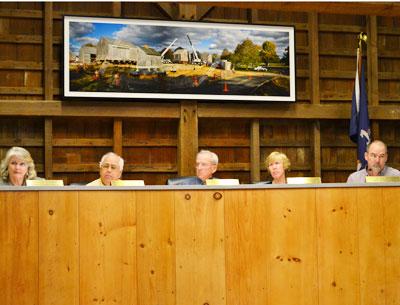Taking On Coastal Erosion Conundrum

Retreat or protect?
That ongoing debate, brought into sharper focus in the wake of Hurricane Sandy, will now get the attention of a new East Hampton Town coastal erosion committee, appointed by the town board on Tuesday to examine such issues as the placement of structures to protect the beach, the dunes, and the houses and businesses beyond them.
Councilwoman Theresa Quigley, who moved for creation of the ad hoc committee, will head it along with Councilman Peter Van Scoyoc, whom she described as her polar opposite on the issues.
Diane McNally, the presiding officer for the East Hampton Town Trustees, was named to the committee. Also appointed were three Montauk waterfront hotel owners, Steve Kalimnios of the Royal Atlantic Beach Resort and Royal Atlantic East, Alice Houseknecht of the East Deck Motel, and Paul Monte of Gurney’s Inn. Thomas Muse of the Surfrider Foundation, who called for the advisory group at a November town board meeting, will serve on the committee, as will Robert De Luca, president of Group for the East End, Wayne Grothy, marine coastal program director for the Nature Conservancy, Chris Coleman, a Montauk real estate broker, and Patrick Bistrian of Bistrian Materials, which handles marine dredging, beach restoration, and revetment construction.
Mr. Grothy, whom the board had met only an hour earlier during the meeting’s public comment period, touted the Nature Conservancy’s model for sea-level rise, available for local and international coastlines, and said that this tool, online at coastalresilience.org, would be useful for short-term, long-term, and emergency land planning.
Councilman Dominick Stanzione said the committee seemed very “Montauk-centric,” and asked that someone from East Hampton Village be included, as well. The board agreed to ask Mayor Paul F. Rickenbach Jr. to appoint a representative.
Ms. Quigley felt strongly that the committee should be kept small. Councilwoman Sylvia Overby did not agree. With a preference for varying points of view, she asked, “Why would we keep it small?”
Ms. Quigley said members could organize their own subgroups that could include anyone else they might find helpful.
With the committee created, its mission is to find common ground between those, including many environmentalists, who believe policy should favor a retreat from the coastline, and those who put asset protection ahead of retreat to save businesses and residences, the supervisor said. If common ground is not found, Ms. Quigley said, town code “is what it is.” The town’s own Local Waterfront Revitalization Plan favors retreat, as it does not support hard structures on the beach in most coastal areas of the town.
Mr. Wilkinson called the L.W.R.P., “a snapshot in time” subject to review in light of events and historical movements.
The intention is for the committee to start with Montauk, but keep the big picture in mind, said Supervisor Bill Wilkinson, because any plan implemented as a result of the discussions would affect other hamlets and beaches.
This is about the economic survival of Montauk, said Mr. Wilkinson. “If you don’t let a motel rebuild or introduce hard structures to protect them, it’s a matter of time,” he said. On the other side, he added, are those that say, “Let it fall in.” The drastically different viewpoints confirm why the committee “critically needs people on both sides,” he said.
The common interest seems to be the beaches, Mr. Wilkinson said. “It’s all about sand,” said Mr. Wilkinson, “that’s our gold. . . . That is our gold mine.”
Ms. Quigley agreed.
Reconciling the differences between those on both sides of the argument is necessary if the committee and any plan that results from it are to succeed, Mr. Stanzione said. “Engineer a beach,” he proposed. “Buy 25 to 30 years of protection without hard structure.” That approach has been discussed before, but it is an expensive one and the question has always been, who would pay?
As the committee begins its work, Mr. Van Scoyoc suggested it first turn its attention to properties in the Montauk business district, which is “extremely low lying.” The area was “overwashed in 1938,” he said, and breached again in 1954. “Short-term solutions are just that,” he said.
Mr. Wilkinson said that the committee would prioritize the different areas affected, since “some are worse off than others.”
